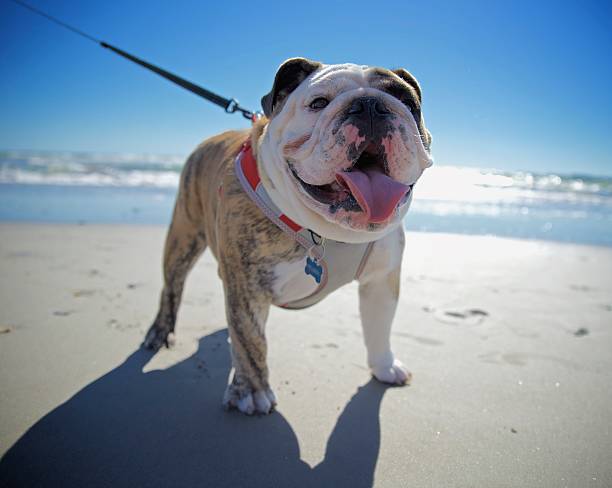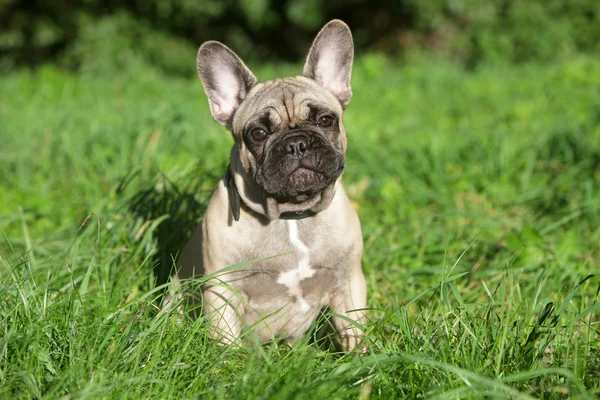The French Bulldog, a delightful embodiment of charm and affection, captures the hearts of dog enthusiasts and families across the globe. With its unique heritage, distinctive appearance, and lovable quirks, this breed has carved out a cherished niche as a companion like no other, carrying a touch of French elegance wherever it goes.

| Category (Explanation) | Breed Information |
|---|---|
| Year of Breed Conception | 1800s (Developed in France) |
| Country of Origin | France |
| Weight (Male) | 20-28 lbs (9-13 kg) |
| Weight (Female) | 16-24 lbs (7-11 kg) |
| Coat Type | Short and smooth |
| Color Variations | Variety of colors including brindle, fawn, cream, and more |
| Shedding Level (Low, Moderate, High) | Low |
| Height (cm & in) | 11-12 inches (28-31 cm) |
| Breed Size | Small |
| Trainability (Low, Moderate, High) | Moderate |
| Mental Needs (Low, Moderate, High) | Moderate |
| Intelligence Level (Low, Moderate, High) | Moderate |
| Energy Level (Low, Moderate, High) | Moderate |
| Agility (Low, Moderate, High) | Moderate |
| Loyalty (Low, Moderate, High) | High |
| Playfulness (Low, Moderate, High) | High |
| Exercise Needs | Low to moderate exercise needs |
| Guarding Proficiency (Low, Moderate, High) | Low |
| Sociability with Children (Low, Moderate, High) | High |
| Barking Level (Low, Moderate, High) | Moderate |
| Digging Tendency (Low, Moderate, High) | Low |
| Destructive Behavior (Low, Moderate, High) | Low |
| Drooling Level (Low, Moderate, High) | Low |
| Obedience Level (Low, Moderate, High) | Low to moderate |
| Apartment Friendly (Yes/No) | Yes |
| Inherent Prey Drive | Low |
| Physical Risk to Others (Low, Moderate, High) | Low |
| Travel Fatality Risk (Low, Moderate, High) | Low |
| Allergen Potential | Low (considered hypoallergenic) |
| Health Concerns (List of Common Health Concerns) | Brachycephalic Syndrome, Hip Dysplasia, Joint Issues |
| Average Life Expectancy (Life Expectancy in Years) | 10-14 years |











































































Woof Mastery is reader supported and our articles may contain affiliate links.
Instead of running third party ads that we have no control of we only use links from high-quality companies we are directly partnered with. Making use of these links come at no cost to you our reader, and in many cases have the extra benefit of discounted rates or sign up bonuses.
If you’re interested you can read more about our affiliate policy here.
We appreciate your support and always insure that the products and services we recommend are high-quality, helpful and relevant to the subject at hand!
The French Bulldog’s history is a delightful tale of cross-cultural adaptation and charm. Originating in England in the early 19th century, these dogs accompanied lace workers who journeyed to France during the Industrial Revolution.
In France, they found new roles, endearing themselves to the working class and artistic communities. The breed’s distinctive appearance, complete with bat-like ears, quickly earned them a special place in French culture.
Their journey from the English lace factories to the heart of French society exemplifies their remarkable adaptability and their uncanny ability to capture hearts wherever they go.
French Bulldogs are now celebrated worldwide for their elegance, affection, and their innate knack for adding a touch of Parisian sophistication to every aspect of life.

What sets the French Bulldog apart is its compact size, bat-like ears, and an affectionate personality that captivates everyone it meets. These dogs are small in stature but big in heart, making them perfect city companions. French Bulldogs are known for their playful and adaptable nature, thriving in both bustling urban environments and cozy homes. Their combination of a petite, lovable appearance and an affectionate disposition makes the French Bulldog truly special.
French Bulldogs were originally bred as companion dogs for lace workers in Nottingham, England. Today, they continue to thrive as charming and adaptable family pets.
French Bulldogs are renowned for their charming and playful personalities. They are affectionate and sociable, often forming strong bonds with their owners. Despite their small size, they are confident and can be a bit stubborn, but they bring joy and affection to their families.
These dogs thrive on human companionship and are known for their sense of humor. French Bulldogs love to entertain their families with their comical antics and are often described as “clowns” due to their amusing behavior. They are highly expressive and use their wide range of facial expressions and vocalizations to communicate with their owners.
French Bulldogs are also known for their adaptability, making them suitable for various living environments, from apartments to larger homes with yards. They enjoy both playtime and leisure, making them versatile companions.
French Bulldogs are beloved for their charming, affectionate, and sociable temperament. They tend to exude friendliness, loyalty, and adaptability, easily forming strong bonds with both their families and strangers.
While their protective instincts are typically mild, training and socialization are essential to address occasional stubbornness and ensure they remain friendly and well-mannered.
Due to their smaller size, leash training is generally straightforward. French Bulldogs are known for their social nature and adaptability to various living situations. Their playful and amiable disposition adds to their reputation as delightful companions for individuals and families alike.
French Bulldogs, often referred to as Frenchies, are small, compact dogs with an irresistible and distinctive appearance. They possess a square-shaped head with a well-defined, broad jaw and a unique bat-like ear shape that stands erect.
These expressive features create an unmistakable charm that endears them to people around the world. French Bulldogs are adorned with a short, smooth coat that comes in a variety of colors, including brindle, fawn, or pied patterns.
This coat not only enhances their signature look but also accentuates their muscular and agile physique. Frenchies possess a muscular neck, leading to a broad chest and sturdy, straight legs. Their tail is typically short and often described as “screwed.”
In terms of size, both males and females stand around 11 to 12 inches (28-31 cm) at the shoulder, and their weight typically ranges from 16 to 28 pounds (7-13 kg).
Overall, the French Bulldog epitomizes a delightful blend of charm, playfulness, and adaptability. Their appearance exudes a compact and friendly demeanor, capturing hearts wherever they go, whether in bustling cities or serene countryside settings. |
French Bulldogs are known for their unique and adorable color variations. The most common color varieties for French Bulldogs include:
French Bulldogs also have a low shedding level. They are not known to be heavy shedders, and their shedding is generally minimal throughout the year. Occasional grooming and brushing with a soft bristle brush can help manage shedding and maintain their coat’s health. Factors that can affect in French Bulldogs are genetics, stress, and climate. Providing a stress-free environment and protecting them from extreme temperature changes can help minimize shedding.
French Bulldogs have short, smooth coats that are low-maintenance.
Brushing: Regular brushing once or twice a week helps minimize shedding and keeps their coat healthy. Use a soft bristle brush or grooming mitt.
Bathing: Bathing should be infrequent, only when necessary, as their skin is sensitive and frequent baths can dry it out. Use a mild dog shampoo and ensure thorough rinsing and drying.
Ears: Clean their ears regularly to prevent wax buildup or infections. Use a damp cotton ball or a veterinarian-recommended ear cleaning solution.
Nails: Keep their nails trimmed to a comfortable length to prevent discomfort.
Teeth: Maintain good oral hygiene by brushing their teeth regularly to prevent dental issues and bad breath. Dental chews or toys can be beneficial.
Eye Care: Watch for signs of irritation or discharge around their eyes and clean as needed with a damp cloth.
French Bulldogs have a low activity level. They are known for their affectionate and easygoing temperament. Here are some key points to consider about their activity level:
French Bulldogs are known for their playful and affectionate demeanor, paired with moderate intelligence. Here are some key points about their intelligence:
French Bulldogs, while not top performers in obedience trials, showcase their intelligence through their affectionate interactions and adaptability. Their moderate intelligence combined with their loving nature makes them excellent family pets. Training and socialization are essential for a well-behaved Frenchie.
French Bulldogs have a curious nature. Puzzle toys, tricks, and games can keep their minds agile and engaged.
Social Interaction: Known for their affectionate nature, they require consistent interaction with their owners to stay happy and content.
Exercise: These little dynamos need moderate exercise to keep their minds active. Short walks or indoor play can be beneficial.
Training and Obedience: Positive reinforcement training helps channel their energy positively and strengthens their bond with their owner.
Routine and Structure: French Bulldogs appreciate a structured daily life. Regular feeding and play schedules are beneficial.
Affection and Attention: They adore being the center of attention and thrive on love and pampering from their family.
Socialization: Introducing them to various environments and beings early on ensures they grow up confident and adaptable.
Safe Environment: A serene and secure space in the home is crucial for them to rest and rejuvenate.
Consistency: Regular routines and consistent training methods are essential for their mental well-being.
Enter The Woof Mastery

Prior to welcoming a French Bulldog into your home, it’s vital to understand their unique needs. French Bulldogs are known for their charming personalities and adaptability to apartment living.
However, their flat faces can make them susceptible to respiratory issues, so they should be protected from extreme heat and strenuous exercise. They require moderate exercise and mental stimulation. Regular cleaning of their facial wrinkles is essential.
Responsible ownership includes being prepared for potential health concerns and veterinary expenses. French Bulldogs thrive on human companionship, so ensure they receive plenty of love and attention in your safe and cozy living environment.
French Bulldogs, despite their small size, have the potential to pose a physical danger if not adequately socialized, trained, or managed. A dog’s behavior largely hinges on individual temperament, upbringing, training, and owner responsibility. Here’s a breakdown of their potential physical danger:
French Bulldogs are renowned for their charming and playful personalities. They are affectionate and friendly, often forming strong bonds with their owners. Despite their small size, they are confident and can be stubborn, but they bring joy and affection to their families.
These dogs thrive on human companionship and are known for their sense of humor. French Bulldogs love to entertain their families with their comical antics and are often described as “clowns” due to their amusing behavior. They are highly expressive and use their wide range of facial expressions and vocalizations to communicate with their owners.
French Bulldogs are also known for their adaptability, making them suitable for various living environments, from apartments to larger homes with yards. They enjoy both playtime and leisure, making them versatile companions.
Like their English counterparts, French Bulldogs often face challenges when it comes to swimming. Here are some factors to consider regarding their ability to swim:
Many French Bulldogs find swimming challenging, and owners should always approach water activities cautiously and prioritize their pet’s safety.
Inculcating good habits and obedience in your French Bulldog puppy is a journey. Their intelligent and affectionate nature means that with the right techniques, they’ll evolve into disciplined and delightful adult companions.
French Bulldogs, much like their canine counterparts, come with their own set of distinctive sounds and vocalizations they employ to communicate. Here are typical noises associated with them:
As with all breeds, understanding the context of a French Bulldog’s vocalizations is essential. While many of their sounds are simply expressions of their personality, some might indicate a need or discomfort. Employing positive reinforcement can help manage any excessive vocal tendencies they might display.
French Bulldogs thrive in homes where they receive love, attention, and a comfortable living environment. Here are some ideal living conditions for French Bulldogs:
Challenges:
When it comes to travel fatality risk for French Bulldogs, consider the following potential constraints:
By addressing these potential constraints and taking necessary precautions, you can help ensure the safe travel of your French Bulldog and minimize travel-related risks.
French Bulldogs are prone to specific health concerns. While not all individuals will experience these issues, French Bulldog owners must be aware of potential health problems and work with veterinarians to maintain their pets’ well-being. Common health concerns for this breed include:
Regular veterinary check-ups, a balanced diet, proper exercise, and responsible breeding practices are imperative. French Bulldog owners should regularly liaise with veterinarians to ensure their pet’s optimal health.
Proper nutrition is essential for the health and well-being of French Bulldogs. Here are some nutritional habits and best practices to consider for this breed:
Breed-Specific Laws (BSL): French Bulldogs, despite their smaller size and friendly demeanor, might occasionally fall under breed-specific laws (BSL) in some areas due to generalizations.
Types of Restrictions: These might range from spaying/neutering mandates, unique licensing, compulsory liability insurance, and muzzling requirements in public spaces to sometimes even ownership bans.
Rationale for BSL: BSLs are usually driven by safety apprehensions concerning specific breeds. Even though French Bulldogs are primarily seen as companion animals, misconceptions can arise.
Controversy: The implementation of BSL is contentious, with critics insisting on concentrating on individual behavior rather than breed stigmatization.
Local Regulations: Before acquiring a French Bulldog, it’s advised to consult local regulatory authorities to comprehend any breed-related rules.
Woof Mastery is reader supported and our articles may contain affiliate links.
Instead of running third party ads that we have no control of we only use links from high-quality companies we are directly partnered with. Making use of these links come at no cost to you our reader, and in many cases have the extra benefit of discounted rates or sign up bonuses.
If you’re interested you can read more about our affiliate policy here.
We appreciate your support and always insure that the products and services we recommend are high-quality, helpful and relevant to the subject at hand!
Myth 1: French Bulldogs Require Extensive Exercise
Myth 2: They Can’t Tolerate Cold Weather
Myth 3: They are Not Good with Children
Myth 4: They Can’t Travel
Myth 5: They are All Bark and No Bite
Myth 6: They are Fragile
Myth 7: They are All the Same Size
Myth 8: They Are Always Clingy
Myth 9: They are Not Good Guard Dogs
Myth 10: They Don’t Shed
The French Bulldog holds cultural significance in various contexts:
While there may not be as many famous French Bulldog owners as there are for other dog breeds, here are a few notable individuals who have been associated with French Bulldogs:
Like many other dog breeds, French Bulldogs have faced several threats and challenges over the years. Some of the significant hazards and issues that have affected the breed include:
The French Bulldog is believed to have been developed from various breeds, with the primary ancestors being the Toy Bulldogs from England and local ratters in France. The breed’s development occurred over several centuries, with influences from different regional strains and breed types. The specific species and strains that contributed to the French Bulldog’s development include:
French Bulldogs are the epitome of charm and companionship. Their petite size and distinctive bat-like ears make them instantly recognizable and utterly irresistible.
These affectionate dogs have an innate ability to form deep bonds with their human counterparts, providing unwavering loyalty and love. French Bulldogs thrive in various living environments and require minimal grooming, making them ideal for busy individuals or families.
Despite their small stature, they possess a big heart and an even bigger sense of humor, often engaging in comical antics that leave everyone in stitches. While they may not be the most active breed, they are experts at snuggling and are always up for a good cuddle session.
French Bulldogs are more than just pets; they become cherished family members, spreading joy and laughter wherever they go. If you’re seeking a loyal, affectionate, and amusing companion, invite a French Bulldog into your life and discover the happiness they bring.